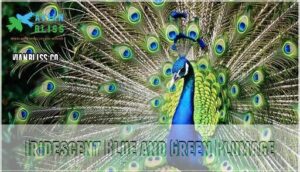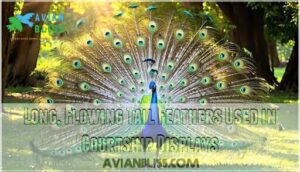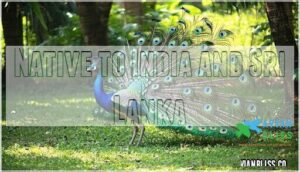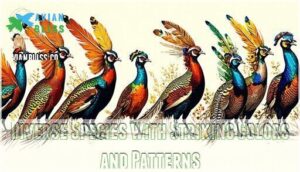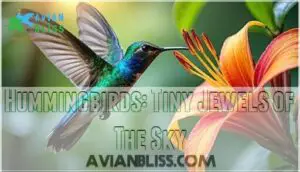This site is supported by our readers. We may earn a commission, at no cost to you, if you purchase through links.
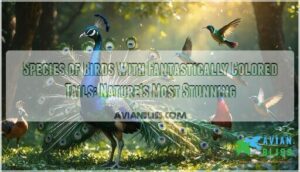
Birds-of-paradise take it up a notch with elaborate tail displays that look like nature’s own fashion show, while sunbitterns surprise with cryptic patterns that suddenly reveal eye-like designs.
These aren’t just pretty decorations—each species uses their colorful tails as sophisticated communication tools for attracting mates and warning rivals, think of them as nature’s billboard advertisements, but infinitely more beautiful and purposeful than anything humans create, serving as elaborate tail displays and cryptic patterns that are also infinitely more beautiful.
Table Of Contents
- Key Takeaways
- Peafowl: Majestic Displays of Color
- Pheasants: Vibrant Woodland Dwellers
- Birds-of-Paradise: Extraordinary Courtship Dances
- Hummingbirds: Tiny Jewels of The Sky
- Sunbitterns: Camouflage and Courtship
- Frequently Asked Questions (FAQs)
- Which species of bird in which the male has a fantastically colorful tail?
- What is the colorful bird with a tail?
- Who has long, colourful tail feathers?
- Which bird is known for its colourful feathers?
- How do birds with colorful tails avoid predators?
- What is the purpose of the long, flowing tails?
- Are there any endangered species with colorful tails?
- How do females choose mates based on tail color?
- Can birds with colorful tails use their tails for communication?
- How do birds grow such colorful tail feathers?
- Conclusion
Key Takeaways
- You’ll discover that birds use their colorful tails as sophisticated communication tools – peacocks vibrate their 150 iridescent feathers at specific frequencies, while hummingbirds create precise aerial signals for territorial warnings and mate attraction.
- You can witness nature’s most elaborate courtship performances through birds-of-paradise, which transform into living rainbows with complex choreography involving feather spreading, tail fanning, and gravity-defying spins that’ve evolved over millions of years.
- You’ll find these spectacular tail displays aren’t just beautiful decorations – they’re evolutionary advantages where longer, more vibrant feathers signal superior genetics and health to potential mates, though they also increase predation risk.
- You can observe dual-purpose tail strategies in species like sunbitterns, which use their cryptic patterns for perfect camouflage against forest floors but suddenly reveal stunning eye-spots to startle predators and attract mates during breeding displays.
Peafowl: Majestic Displays of Color
You’ll find that male peacocks create nature’s most spectacular tail displays, spreading up to 150 iridescent blue-green feathers in a magnificent fan that’s designed to catch a female’s attention.
These impressive five-foot trains aren’t just for show—they vibrate at specific frequencies during courtship, creating a mesmerizing performance that’s helped make peafowl one of the world’s most recognizable birds.
Iridescent Blue and Green Plumage
When you spot a peafowl’s iridescent plumage, you’re witnessing nature’s masterpiece of structural coloration. The feather microstructure creates light refraction that shifts between brilliant blues and emerald greens, giving these birds an evolutionary advantage in attracting mates through enhanced color perception.
Nature’s living prisms transform sunlight into shimmering emerald and sapphire masterpieces that dance with every graceful movement.
You can even find craft supplies available made from these feathers.
- Microscopic platelets split sunlight into rainbow hues
- Feather iridescence changes as the bird moves and turns
- Vibrant bird tails shimmer like liquid metal in daylight
Long, Flowing Tail Feathers Used in Courtship Displays
Male peafowl transform their five-foot-long tail feathers into stunning courtship displays that’ll leave you breathless.
These magnificent plumes create mesmerizing mating rituals through vibrating frequencies and strategic positioning. The evolutionary advantage is clear: longer, more vibrant feather displays attract superior mates, though increased predation risk comes with such eye-catching plumage.
As detailed on a webpage about birds with long tails, these feathers also play a vital role in communication.
| Display Feature | Purpose |
|---|---|
| Tail vibration | Mesmerize females |
| Feather spreading | Show plumage quality |
| Eye-spot patterns | Demonstrate fitness |
Native to India and Sri Lanka
These stunning Peacock displays originate from their ancestral homes across the Indian subcontinent.
You’ll find Indian Peafowl roaming freely through India’s forests and grasslands, while their close cousins inhabit Sri Lanka’s tropical landscapes.
This Regional Avifauna represents some of nature’s most spectacular Endemic Species, with their colorful tails serving as evolutionary masterpieces.
- Indian Peafowl – India’s national bird species with iridescent plumage
- Sri Lankan Peafowl – Distinctive subspecies with unique markings
- Cultural Significance – Sacred symbols in Hindu traditions
- Conservation Status – Habitat Conservation efforts protect remaining populations
Pheasants: Vibrant Woodland Dwellers
You’ll discover that pheasants create some of nature’s most impressive tail displays, with species like the Golden Pheasant showing off black and cinnamon feathers accented by bright red patches.
These woodland birds use their elaborate tail plumage for courtship dances and territorial shows across Asia’s forests and grasslands, where males compete to attract mates with their striking color combinations, showcasing their unique tail displays.
Diverse Species With Striking Colors and Patterns
You’ll discover pheasants showcase remarkable species variation through their colorful bird species diversity.
Feather iridescence creates stunning vibrant colors across different breeds, while color genetics drive unique bird tail patterns in each variety.
Golden pheasants display fiery orange capes, Lady Amherst’s sport zebra-striped tails, and other exotic bird tails reveal how pattern evolution shaped their magnificent plumage for survival and courtship success.
Some species get their color from melanin and carotenoids, which produce vibrant yellows, oranges, and reds.
Tail Feathers Used for Mating Rituals and Territorial Displays
When you watch pheasants during breeding season, you’ll witness nature’s most elaborate mating rituals.
Males fan their colorful tails in spectacular courtship displays, creating feather vibrations that mesmerize females.
This bird tail display showcases signal complexity through iridescent patterns.
Mate selection depends on tail brilliance, while territory defense involves aggressive posturing.
Display evolution has perfected these tail feathers into irresistible romantic advertisements.
These feathers are available for artistic and craft uses.
Found in Forests and Grasslands Across Asia
You’ll find Asia’s most spectacular pheasants across diverse landscapes, from dense forests to open grasslands.
Golden pheasants showcase brilliant iridescent plumage in China’s woodlands, while Lady Amherst’s pheasants display striking zebra-striped tails in Myanmar’s hills.
These regional birds have evolved remarkable tail morphology through countless mating rituals.
Unfortunately, Asian habitats face mounting pressure, making regional conservation efforts critical for preserving these colorful tails.
Birds-of-Paradise: Extraordinary Courtship Dances
Deep within New Guinea’s tropical forests, you’ll witness nature’s most spectacular show when BirdofParadise males begin their Courtship Displays. These feathered performers have mastered Mating Rituals that’ll leave you speechless.
These feathered performers transform into living rainbows, spinning and dancing in displays that defy imagination itself.
Through millions of years of Dance evolution, males developed complex choreography involving Feather spreading, tail fanning, and gravity-defying spins. The males’ dances are part of their courtship rituals.
- Males perform complex dances, often incorporating:
- Spreading and fluffing their feathers
- Raising and fanning their tails
- Hopping, gliding, and spinning in elaborate patterns
- Females carefully observe and choose their mates based on the males’ dancing prowess and the brilliance of their tail feathers.
- The dances serve not just to attract mates but also to establish territories and communicate with other birds-of-paradise.
These Ritualistic displays showcase Bird Behavior at its finest, demonstrating how Mate selection and Territory establishment drive evolution’s most dazzling performances.
- The Carola’s parotia performs six different dance moves in perfect sequence, transforming from a black bird into a shimmering UFO-like spectacle that defies belief.
Hummingbirds: Tiny Jewels of The Sky
You’ll discover that hummingbirds possess some of nature’s most spectacular tail feathers, featuring microscopic structures that create brilliant, shifting colors without using any pigments at all.
These tiny aerial acrobats use their iridescent tail feathers not just for stunning flight displays, but also for precise communication and territorial signals across their vast range from Alaska to Chile, utilizing their feathers for stunning flight displays and precise communication.
Iridescent Feathers That Shimmer in The Light
You’ll witness nature’s most brilliant optical illusion when sunlight hits hummingbird feathers.
Their iridescent plumage creates shimmering pigments through light interference, not actual color pigments.
Microscopic feather structure contains platelets that split light waves, producing those dazzling greens, reds, and purples.
This feather iridescence offers an evolutionary advantage by attracting mates while confusing predators with constantly shifting colors.
These birds belong to the family Trochilidae, which is a key part of their unique characteristics.
Tail Feathers Used for Aerial Displays and Communication
You’ll marvel at how hummingbirds transform their tail feathers into precise communication tools through aerial communication and intricate feather displays.
These bird tail feathers create stunning visual signals for species recognition across impressive signaling distance.
Through millions of years of display evolution, feather aerodynamics enable complex courtship dances and territorial warnings.
Their bird tail communication showcases remarkable avian biology in action.
Found in The Americas, From Alaska to Chile
You’ll spot these dazzling tail displays across the Americas’ vast range.
From Alaska’s ruby-throated visitors to Chile’s green-backed firecrowns, hummingbirds showcase incredible regional variations.
Central American birds like quetzals display emerald quetzal plumage, while South American birds feature unique spatuletail shapes.
These tropical birds and their colorful tails create nature’s most spectacular light shows from north to south.
Many species thrive in Ecuador, which boasts high hummingbird diversity, and is known for its high diversity of hummingbird species.
Sunbitterns: Camouflage and Courtship
When you spot a sunbittern along a jungle stream, you’ll notice how its mottled brown feathers blend perfectly with fallen leaves until it suddenly spreads its wings to reveal stunning orange, black, and white eye-spots that can startle both predators and admirers.
You’ll find these secretive birds using their cryptic tail feathers and wing displays both to confuse threats and to attract mates in the dense tropical forests of Central and South America, where their ability to blend in is crucial for survival, and their stunning displays serve as a form of courtship.
Cryptic Plumage With Eye-like Patterns on The Wings
When you glimpse a sunbittern in the forest, you’ll notice its mottled brown and white plumage creates perfect camouflage against dappled sunlight.
However, the real magic happens when it spreads its wings, revealing spectacular eyespots with intricate feather patterns.
This wing morphology represents millions of years of camouflage evolution, using pattern recognition and predator deception to survive in tropical woodland habitats.
Tail Feathers Used for Courtship Displays and Startling Predators
You’ll discover that sunbitterns use their fantastically colored tails strategically for dual purposes.
During courtship displays, males spread their iridescent bird tails alongside wings, creating stunning visual spectacles for mate selection.
When threatened, these same tail feathers serve as predator deterrents, startling attackers with sudden flashes of brilliant patterns.
This remarkable tail morphology showcases display evolution at its finest.
Found in Tropical Forests of Central and South America
From Mexico’s cloud forests to Brazil’s Amazon basin, you’ll find sunbitterns showcasing their fantastically colored tails across tropical forests of Central and South America.
These elusive birds contribute to forest biodiversity through canopy ecology interactions, demonstrating millions of years of avian evolution.
Their plumage, like the Scarlet Macaw’s colors, aids in communication and camouflage.
Here’s where you’ll spot them:
- Riverine forests near streams
- Wooded wetlands with dense vegetation
- Forest floors with dappled sunlight
- Tree canopies during breeding displays
Frequently Asked Questions (FAQs)
Which species of bird in which the male has a fantastically colorful tail?
You’ll find the male peacock’s the showstopper here, sporting around 150 iridescent tail feathers in brilliant blues and greens.
Each feather features that iconic eye-spot that’s absolutely mesmerizing during his courtship display performances.
What is the colorful bird with a tail?
Like a living rainbow unfurling across your backyard, you’ll spot the male peacock displaying his stunning tail.
These magnificent birds showcase iridescent blue-green feathers adorned with mesmerizing eye-spots that shimmer brilliantly in sunlight, creating a truly mesmerizing display.
Who has long, colourful tail feathers?
You’ll spot peacocks with their stunning 150 iridescent tail feathers featuring vibrant blues and greens.
Birds-of-paradise males also boast spectacular long, colorful plumes, while ribbon-tailed astrapias showcase three-foot-long tail feathers for courtship displays.
Which bird is known for its colourful feathers?
Beauty is in the eye of the beholder, and you’ll find peacocks steal the show with their stunning iridescent blue-green tail feathers.
These magnificent birds display vibrant colors that shimmer like jewels in sunlight.
How do birds with colorful tails avoid predators?
You’d think bright tails make birds easy targets, but they’re actually clever defense tools.
When threatened, birds like peacocks suddenly flash their stunning feathers, startling predators long enough to escape safely.
What is the purpose of the long, flowing tails?
You’ll find these magnificent plumes serve as nature’s romantic billboards – they’re courtship tools that attract mates, establish territories, and communicate fitness.
Longer, more vibrant tails signal superior genetics and health to potential partners.
Are there any endangered species with colorful tails?
Yes, you’ll find several endangered species with stunning tail displays.
The marvelous spatuletail from Peru’s Andes faces extinction, while ribbon-tailed astrapia and Wilson’s bird-of-paradise are near threatened due to hunting and habitat loss.
How do females choose mates based on tail color?
Females favor flashy feathers when selecting suitors.
You’ll notice peahens preferring males with brighter, more iridescent tail displays.
Longer, more colorful tails signal genetic fitness and health, making these males irresistible breeding partners.
Can birds with colorful tails use their tails for communication?
You’ll discover that colorful-tailed birds absolutely use their plumage for communication beyond mating.
They signal territorial boundaries, show aggression, express submission, and convey social status through specific tail positions, movements, and feather displays within their flocks.
How do birds grow such colorful tail feathers?
Ever wonder how birds create their stunning tail displays?
You’ll be amazed that specialized cells called chromatophores produce pigments like carotenoids and melanins, while microscopic feather structures reflect light to create brilliant blues and greens.
Conclusion
Truly, these species of birds with fantastically colored tails represent evolution’s most spectacular achievements in visual communication.
You’ve witnessed how peacocks, pheasants, birds-of-paradise, hummingbirds, and sunbitterns transform simple feathers into dazzling displays that serve critical survival functions.
Each tail tells a story of adaptation, courtship, and territorial defense.
Next time you spot one of these magnificent creatures, you’ll appreciate the incredible complexity behind their breathtaking beauty and understand why nature’s artistry surpasses human imagination.

